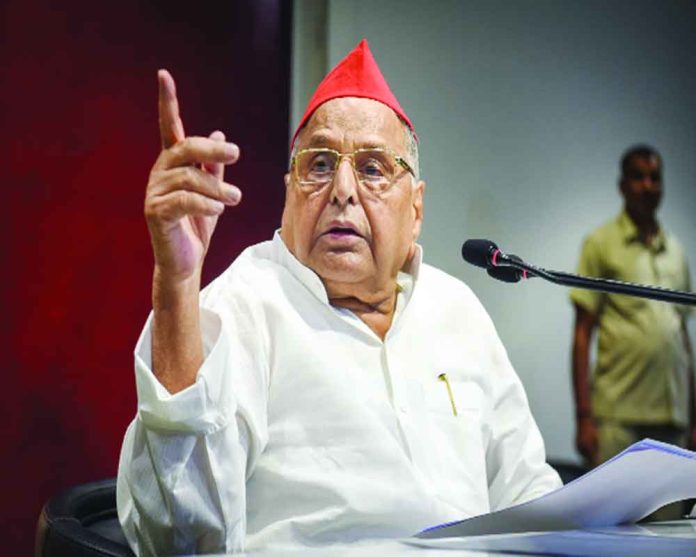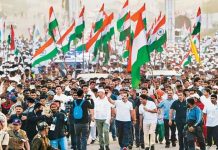By Chanakya
Mulayam Singh Yadav, the last socialist leader of India, breathed his last on October 10 in a Gurugram hospital. India has lost another great political mind, a free thinker and a leader of people, who never played around with the trust his people placed in him. For a man who grew up with the ideologies of Ram Manohar Lohia and Jayprakash Narayan in his heart, he was a giant, despite his diminutive stature, a man among men.
It may be true that, in his 82-year life, he may have deviated a lot from any straitjacketed path that his ideologies would have wanted him to take, but one needs to remember that realpolitik is often a shade darker, a degree too far to the left or right than any white paper on the ideology can dictate. Yet, Mulayam rarely forgot his roots, his people, his real strength.
How many leaders today can dare to stick to those old principles of politics, of knowing his/her constituency by heart; of knowing the people through and through; of having interacted with rich and poor alike; of having the ability to be humble before hoi polloi, yet remaining superbly alert, guarding against enemies from without, displaying an iron will and often arrogance when conditions demanded it.
Those are rare traits; traits of a political ideologue, who also knows on which side of the rock the moss grows. Therefore, he was a person who never needed a compass, a coterie of suck-ups to advise. He had his own people, the trusted ones, no doubt, but there was no Congress-like crass domination of the coterie over policy. For Mulayam, the manifesto of the party was important, more important than the dribbling of advice from self-seekers.
Of course he was cruel to a point – that has been dismissed as collateral damage by his fans – but that was utter callousness, nevertheless. Yet, in doing his politics the old way – he did not have the advantage of social media messages or long distance alliances – he never baulked from a face-to-face meeting, even if it was with his arch enemy.
One may assume that these were qualities that maybe his wrestling career left him with, or values that education and a teaching career ingrained in him.
Even his socialist leanings have been doubted over the years, when he cosied up to business leaders, especially with the help of Amar Singh. But even in his late years, when the phone had stopped ringing and the house was darker that he would have liked it to be, he would ask “bahar koi hai kya?” (is there somebody outside?). He missed his people, his state, his constituency in every breath.
A Neta of a kind
In Uttar Pradesh, he was popularly known as ‘Netaji’, not to be confused with Subhas Chandra Bose, who was the country’s ‘Netaji’. He was also the founder of the Samajwadi Party. He not only served as the Chief Minister of Uttar Pradesh thrice, but also as the former defence minister of India. He represented Mainpuri, Azamgarh, and Sambhal as his constituencies while he was elected as a member of parliament (MP).
Condolences
Prime Minister Narendra Modi, Home Minister Amit Shah, Defence Minister Rajnath Singh, and Chief Ministers of several states expressed their grief and sent in their condolences on Mulayam’s death. The death of Mulayam Singh Yadav has made his followers sad and upset. Akhilesh tweeted, “Mere adarniya pitaji aur sabke Netaji nahi rahe” from the official Twitter account of the Samajwadi Party. The last rites were performed at Saifai village.
The funeral took place at his native Saifai village in the Etawah district of Uttar Pradesh on October 11 afternoon. People in large numbers were headed for the last rites of the Samajwadi Party founder in Saifai, the intermittent morning drizzle adding to the sombreness.
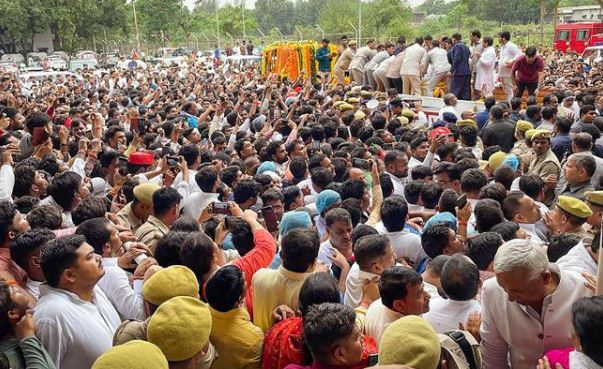

Party workers and people in their hundreds riding cycles, motorcycles, cars, SUVs and other means of transport were headed to Saifai from nearby areas on October 11, 2022 morning for the final rites.
Leaders who participated were defence minister Rajnath Singh, Bihar Deputy Chief Minister Tejaswi Yadav, Mulayam Singh Yadav’s brother and BSP leader Shivpal Yadav, DMK Lok Sabha Committee Chairman DR Balu, DMK Youth Leader Udayanidhi Stalin and others.
Early life
Mulayam Singh Yadav was born in Saifai village of Etawah district in Uttar Pradesh on November 22, 1939 to Murti Devi and Sughar Singh Yadav. He completed his primary education in Saifai and, after school, went on to do his BA in political science from Karm Kshetra Post Graduate College, Etawah. He later did B.T. from AK college in Shikohabad and then went to Agra to pursue his post graduate degree. In Agra, he took admission to B.R. College and completed his master’s from there. He began working as an assistant teacher at the AK College in Shikohabad.
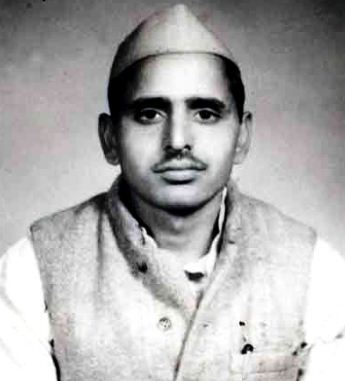

After completing his master’s degree in political science, he got promoted as a lecturer with a salary of Rs 120 per month.
Mulayam Singh Yadav had two wives. Her first wife was Malti Devi, who passed away in 2003. Akhilesh Yadav was the only child of Mulayam Singh Yadav and his wife Malti Devi. After the death of his first wife Malti Devi, Mulayam Singh Yadav married Sadhana Gupta. It is said that Mulayam Singh Yadav was in a relationship with Sadhana Gupta while he was married to Malti Devi.
Later, after Malti Devi’s death, Sadhana and Mulayam married.
Mulayam Singh Yadav has one son, Akhilesh Yadav. Akhilesh has been the former Chief Minister of Uttar Pradesh from 2012 to 2017.
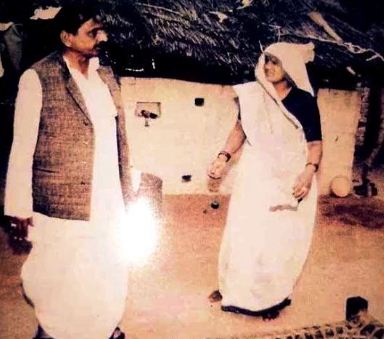

The political turn
Mulayam, who dreamed of becoming a wrestler in his youth, was influenced by Ram Manohar Lohia, a strong leader of socialist politics, at the age of only 14. The influence of Lohia’s socialist ideas was so strong that he went to jail for the first time at this age. Further, during his college days, the influence of socialist ideas of Ram Manohar Lohia and Raj Narayan increased on Mulayam. He became the president of the students’ union of his college. This was the period when Lohia’s Samyukta Socialist Party (SSP) was campaigning against the abolition of casteism, price hikes and the English language.
Mulayam started electoral politics from Jaswantnagar in 1967 on an SSP ticket and became an MLA from this seat.
Patronage of Chaudhary Charan Singh
After Ram Manohar Lohia, Mulayam Singh Yadav became a disciple of strong farmer leader Chaudhary Charan Singh. After Lohia’s death in October 1967, Mulayam joined Charan Singh’s Bharatiya Krishak Dal (BKD). In 1974, Mulayam became an MLA again with a BKD ticket.
In 1974, the Socialist Party and the Bharatiya Krishak Dal merged and the new party was named Bharatiya Lok Dal (BLD). In 1977, the BLD also merged with the Janata Party. In the midst of all this, Mulayam Singh Yadav went on to learn the secret tricks of politics under the umbrella of Chaudhary Charan Singh.
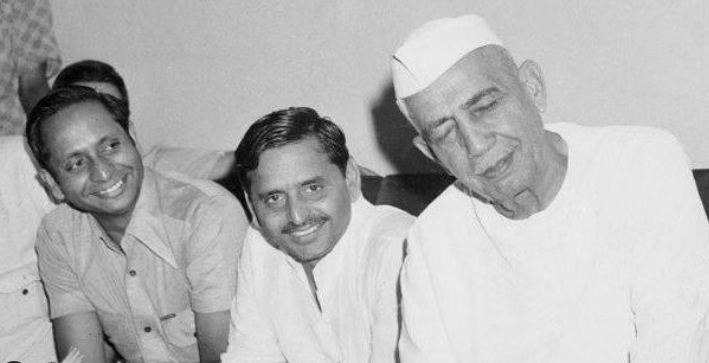

In 1979, Chaudhary Charan Singh left the Janata Party and formed a new party by the name of Lok Dal. Mulayam remained with him even then. When Charan Singh’s adopted son Mulayam lost the assembly elections in 1980, Charan Singh made him a member of the Legislative Council and also appointed him the state president of the Lok Dal in UP.
A change in fortunes
Mulayam had hoped that he would be Charan Singh’s political successor, but in the mid-1980s, Charan Singh handed over the succession reins to his apolitical son Ajit Singh of Chaudhary Sahab. Charan Singh died in 1987. Lok Dal broke into two factions – one part went with Charan Singh’s son Ajit Singh. Second with Mulayam Singh Yadav.
Connection with Amar Singh
Amar Singh, once called the Chanakya of Uttar Pradesh politics, became what can be called the ‘fixer’ of Mulayam Singh Yadav’s troubles. When Amar Singh, a businessman and wheeler-dealer with a Kolkata base entered politics, he became a close friend of Mulayam. The story of their first meeting is interesting. Mulayam was the defence minister of the country at that time, in 1996. Amar Singh was also aboard the flight in which Mulayam Singh was travelling in and as the two met, the closeness between the two developed into a friendship.


Political experts believe that Amar Singh played a big role in bringing SP to the top of UP politics and getting Mulayam Yadav to be the chief minister of UP. Amar Singh, who had ‘the treatment of every merge’, had huge reach in the film industry, extending to even Amitabh Bachchan’s family.
Other influencers on the way
Dr Ram Manohar Lohia’s beliefs had a great impact on Mulayam, but even from age 15, he had the opportunity to interact with individuals like Karpoori Thakur, Janeshwar Mishra and Ram Sewak Yadav. His being head of the students’ union at A.K. College in Shikohabad in 1962 helped in this.
He became the youngest member of the state assembly when he contested elections in 1967 for a socialist party. He was elected in 1974 and again in 1977, when he romped home, still as a fervent socialist, but representing a different party.
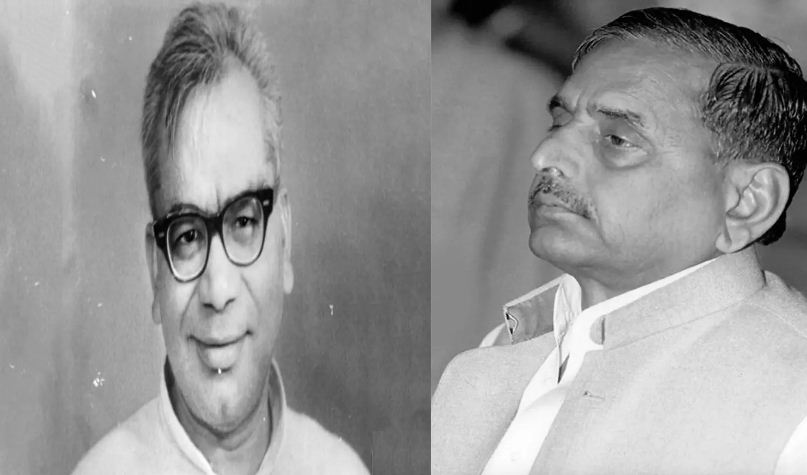

Typical of the mercurial nature of his career were the elections of 1980 when, for the first time, he lost amid a surge of support for the Congress party. In 1980, he was chosen to serve as the Janata Dal’s president.
During Indira Gandhi’s imposition of Emergency, Mulayam Singh Yadav was among the leaders who were arrested and kept in custody for 19 months because of the protest.
In 1977, Mulayam became a state minister and in 1980 became the President of the Lok Dal in Uttar Pradesh which afterwards became a part of Janata Dal. In 1983, Mulayam Singh Yadav was elected as the leader of the Opposition in the UP Legislative Council and held that post until 1985
The caste politics
Till the late 1980s, Uttar Pradesh politics was dominated by the so-called upper castes, Brahmins and Rajputs being the prominent communities. The rise of dominant castes, also called other backward classes or OBCs, after the implementation of the Mandal Commission recommendations helped his case. He, along with Lalu Prasad Yadav of Bihar and to some extent Nitish Kumar, emerged as major leaders in north India. All of them were also torchbearers of the socialist movement, but after Mandal this movement became associated with casteism, though now it was also known by the fancy name of social engineering.
Politics in the Hindi heartland, though, increasingly came to be seen as a Yadav hegemony. That happened both in UP and Bihar. Mulayam was never doctrinaire in economic policy; he never tried to be seen as anti-business. With Amar Singh part of his entourage, Mulayam Singh even got close to some business leaders, but that was widely viewed as an exercise in cronyism rather than a genuine pro-industry policy shift. At least, that didn’t reflect in governance.
Under him, though, the law and order situation was seldom satisfactory. His son, Akhilesh, too couldn’t take care of the governance deficit. Still, Mulayam Singh will be remembered as a leader who made democracy more inclusive.
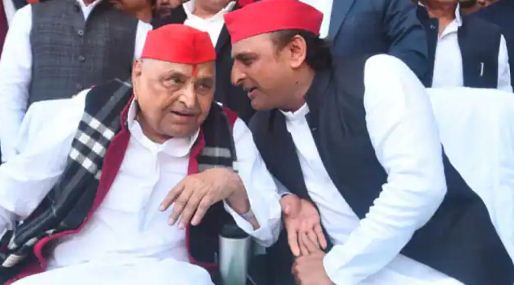

His first stint as chief minister in Uttar Pradesh – from 1989 to 1991 – was short lived but not uneventful. It culminated in his party formally separating from Congress, whose support it depended upon.
The black spot
After October 30, 1990, when as UP chief minister, Mulayam Singh ordered the police to open fire at karsevaks who had gathered in Ayodhya. People’s dislike turned into hatred. He was derisively called as ‘Maulana Mulayam.’ In less than a decade, however, hatred metamorphosed into sympathy when he put a spoke in Sonia Gandhi’s wheel in 1999 when she made a bid to become prime minister.
Birth of the Samajwadi Party
In 1992 Mulayam founded his own Samajwadi Party (Socialist Party). In 1993, he allied with the Bahujan Samaj Party for the elections to the Uttar Pradesh assembly due to be held in November 1993. The alliance between Samajwadi Party and Bahujan Samaj Party prevented the return of BJP to power in the state.
Yadav became chief minister of Uttar Pradesh with the support of Congress and Janata Dal. His stand on the movement for demanding separate statehood for Uttarakhand was as controversial as his stand on the Ayodhya movement in 1990 was. There was a firing on Uttarakhand activists at Muzaffarnagar on October 2, 1994, something for which Uttarakhand activists held him responsible. He continued holding that post until his ally opted into another alliance in June 1995.
Third term as CM
In 2002, following a fluid post-election situation in Uttar Pradesh, the Bharatiya Janata Party and Bahujan Samaj Party joined to form a government under Dalit leader Mayawati, who was considered to be Yadav’s greatest political rival in the state. The BJP pulled out of the government on August 25, 2003, and enough rebel legislators of the Bahujan Samaj Party left to allow Yadav to become the chief minister, with the support of independents and small parties. He was sworn in as chief minister of Uttar Pradesh for the third time in September 2003.
Mulayam was still a member of the Lok Sabha when he was sworn in as chief minister. In order to meet the constitutional requirement of becoming a member of state legislature within six months of being sworn in, he contested the assembly by-election from Gunnaur assembly seat in January 2004. Mulayam won by a record margin of 1,83,899 votes, polling 91.45 per cent of the votes.


With the hope of playing a major role at the centre, Mulayam contested the 2004 Lok Sabha elections from Mainpuri while still Chief Minister of Uttar Pradesh. He won the seat and his Samajwadi Party won more seats in Uttar Pradesh than all other parties. However, the Congress party, which formed the coalition government at the centre after the elections, had the majority in the Lok Sabha with the support of the Communist parties. As a result, Mulayam could not play any significant role at the centre. Mulayam resigned from the Lok Sabha and chose to continue as chief minister of Uttar Pradesh until the 2007 elections, when he lost to the BSP.
PM ambitions
In the summer of 1996, he won his first break in central politics when he was appointed India’s defence minister in a United Front coalition government, which was led by HD Deve Gowda. Ambitious as ever, at one point Yadav even tried to become prime minister, but he always lacked a strong support base despite being at the centre of ceaseless political intrigue.
Evidence of this was clearly seen when he took the decision to oppose Sonia Gandhi’s candidature for prime minister after the fall of the 13-day government of BJP leader Atal Behari Vajpayee in 1996.


Yadav described her as a “videshi” (foreigner) – a mistake that came back to haunt him when Sonia and Congress refused to support him when he needed it while trying to form a government in Uttar Pradesh as the single largest party following polls in February 2002. This meant his arch-rival Mayawati was able to seize the moment instead.
Political Journey
- In 1967, he was elected Member of Legislative Assembly of Uttar Pradesh.
- In 1977, he became a State Minister for the 1st time.
- He became President of Lok Dal in 1980.
- He held the post of Leader of Opposition in the Uttar Pradesh Legislative Council from 1982 to 1985.
- In 1989, he became the Chief Minister of Uttar Pradesh for the 1st time.
- In 1990, he joined Chandra Shekhar’s party Janata Dal (Socialist).
- In 1992, he founded Samajwadi Party (Socialist).
- In 1993, he became Chief Minister of Uttar Pradesh for the 2nd time.
- In 1996, he was elected to the 11th Lok Sabha from Mainpuri.
- In 1999, he became India’s Defence Minister in the United Front Coalition Government.
- In 1998, he was elected again to the Lok Sabha.
- He contested from two seats- Sambhal & Kannauj in the 1999 Lok Sabha Elections and won both the seats.
- In September 2003, he became Chief Minister of Uttar Pradesh for the 3rd time.
- In 2004, he won the Gunnaur assembly seat in a by-election with a victory margin of 183,899, which is a record so far.
- In 2004, he won the Lok Sabha election from Mainpuri.
- In 2014, he contested 16th Lok Sabha from 2 seats- Azamgarh & Mainpuri and won both the seats.
- In the 2019 Lok Sabha Elections, he defeated BJP’s Prem Singh Shakya by a margin of over 94,000 votes from Mainpuri.

